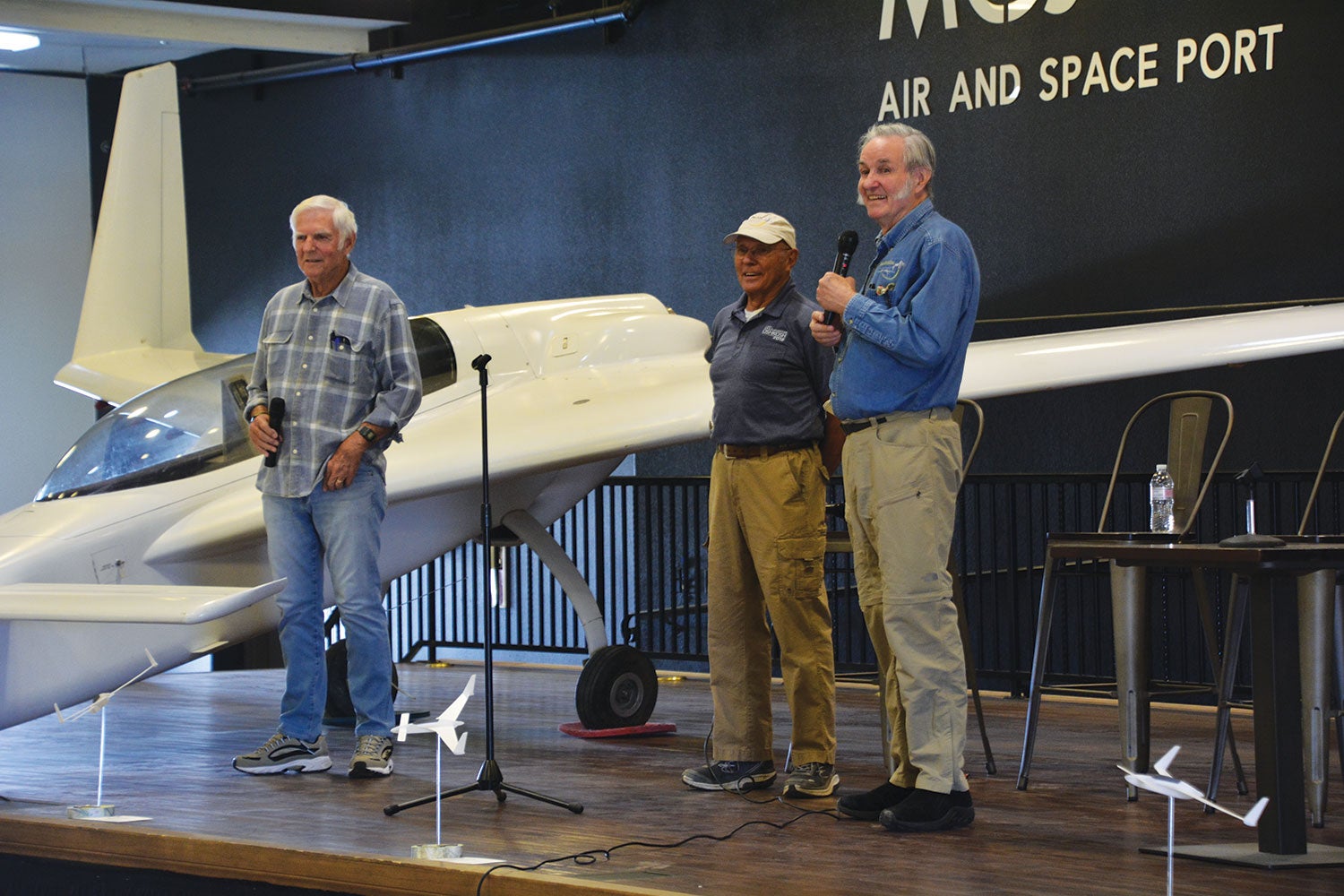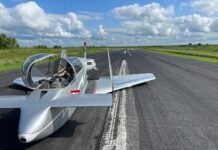
If there’s a chance to meet or hear an aviation celebrity speak, it’s my observation it’s worth the effort. Much of this is just feeding an interest skewed to history, and I understand my more successful friends who file such field trips in the “nice but not necessary” folder. But I always seem to learn something, which helps understand why things are as fouled up as they are—and possibly how they might be un-fouled.
So it was when the Mojave Transportation Museum, the nice folks putting on monthly talks and fly-ins at their spaceport-in-the-sand flying place, announced Burt and Dick Rutan, plus test pilot Mike Melvill, were going to speak last fall that I saddled up the box kite and made the scene.
Now, thanks to AirVenture, and more specifically, nights at the Theater in the Woods presentations, no doubt a large percentage of KITPLANES® readers have had the chance to hear a few Rutan war stories told in the first person—or even more toe-curling, you’ve heard Mike give his take on test flying Rutan Aircraft Factory and Scaled Composite flying things. They’re fabulous tales, but we’re not going to repeat many of them here as I want to fry other fish this time around.
To set the tone, Burt observed that he, his brother Dick, along with Mr. Melvill, had appeared before many audiences, but the intimate gathering at the Mojave luncheon was a more select bunch as we were there ostensibly celebrating the 40th anniversary of the Long-EZ, and judging from all the funny looking airplanes on the ramp, most of the audience already had a close personal understanding of the canard club. So instead of re-plowing familiar ground, Burt turned the proceedings into one big Q & A session. Not only did that make the meeting more responsive to the audience, it also gave us more insight as to what was of interest to the modern Rutan fan.
Somewhat curiously, while there were Long-EZ specific questions, mainly surrounding the gestation of the airplane from its VariEze predecessor, much of the time was spent on Voyager and SpaceShipOne, understandably the legacy projects of the Rutan era. In the Long-EZ arena the honesty displayed by the trio in how horrible the first article Long-EZ was to fly was enlightening. Apparently it was a real stinker, a terrible mess of instability and of the Rutan Aircraft Factory designs, everyone’s least favorite. As Mike mentioned in the casual chatting after the talk, it wasn’t as if everything Burt designed came out perfectly the first time, but that, “We’d put bigger winglets on them and everything would be OK.” For sure it was more complex than that, but the take-home was even a great designer needs a prototype or two.
In the Long-EZ’s case, some of the prototype’s shortcomings resulted from pragmatic expediencies, such as using the lighter VariEze’s wings and adding sweep back to account for the heavier engine (VariEze’s used VW or Continental O-200 engines; Long-EZs fitted the heavier Lycoming O-235). Legendary airplane designer or not, as usual the prototype Long-EZ was zoomed to completion just in time for Dick to fly it nonstop to Oshkosh 1979. Then, as Dick put it, “We went home and started over.” The capital improvement—a new Eppler airfoil with less sweep back—is what made the completely rethought Long-EZ the winner we know today according to the Rutans. In typical fashion they had the second Long-EZ flying by November of the same year.
While the VariEze and the Long-EZ were both wonderfully successful—the Long-EZ is said to be the most prolifically constructed plansbuilt homebuilt design ever, a fact undeniably true if limited to composite construction aircraft—ultimately Burt stepped away from the amateur-built market. After just five years the RAF ceased sales of Long-EZ plans; thereafter the Rutan Aircraft Factory was mainly shuttered to the public, and Burt was on to commercial and government prototyping via his new Scaled Composites company. In his remarks, Burt gave us a hint why.
“It’s an enormous job making the public safe, including the D and F students,” is how he put it. This after noting any teacher will tell you they spend the majority of their time on their D and F students while the A and B students get bored. Translated into the business of servicing the come-one, come-all amateur-built market, this boils down to builder support. You can draw great plans, you can write clear instructions, you can print clear, informative photos, and you’ll still wile the days away on the phone answering questions already addressed in the plans, reassuring the timid, satisfying those who simply want glorification by communicating with the Great Man or patiently guiding the hopeless who you hope will never fly, especially in one of your designs.
In short, builder support wore Burt out. “It was really tough…and I realized it was not something I wanted to spend the rest of my life doing.”
This makes perfect sense, and thank all goodness Burt moved on. The statement that Burt Rutan is an entrepreneurial designer needs no justification, and entrepreneurs must be forging the future, not tending the present—a job for more mainstream, business-oriented thinkers. It would have been to our benefit if the RAF canard line had continued to receive the support it deserved after Burt and the gang moved on, but plansbuilt anything, much less scratch-built composite airplanes, were not the future no matter what business case surrounded them. Of course the move unleashed Burt, and perhaps it’s not a step too far to say the divorce of Burt from the legacy RAF business was a big step in allowing Voyager and SpaceShipOne to come to pass.
It’s enough to make you think twice before dialing up the factory with a question, eh?
As for the future, the trio remains steadfastly infatuated with what’s possible and in love with flight. But they’re also seasoned by the realities of our age. Noting he had been involved in many fascinating projects—only some of which made it to flight or the public sphere—Burt spoke of projects that began full of promise but were run to ground by corporate minders, technically conservative managers, liability lawyers, review boards and big investors—anyone who couldn’t abide a public failure with their corporation’s name attached to it. “You must take huge risk to make breakthroughs,” he observed, and that’s something currently intolerable in the information age.
More personally, while Dick still seems a bit keen, the three are clearly retired and beyond any hands-on derring-do. What we can wish for are detailed biographies as it seems the best insights from these lives well spent have yet to be told.













